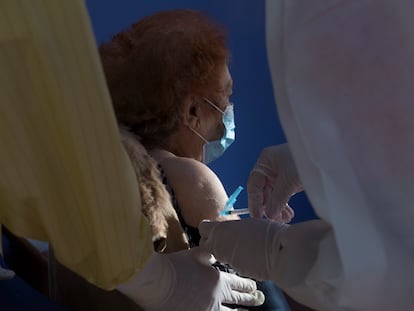Spain reports 41,576 new coronavirus cases, the highest single-day figure so far
According to the latest data, the occupancy rate in hospitals and intensive care units is now worse than it was during the first wave in April

The Spanish Health Ministry on Wednesday reported 41,576 new coronavirus cases, the highest number registered in a 24-hour period since the start of the pandemic. On January 7, the Health Ministry recorded 42,360 new infections, but this figure also included cases reported on January 6, which was a public holiday for King’s Day meaning no data was released.
Wednesday’s report shows that the pandemic is on a clear upward trend. The number of infections reported over a seven-day period – a data point that fluctuates less as it is not affected by underreporting over the weekends – has been rising uninterruptedly since December 8, when it was below 45,000. On Wednesday, that figure jumped to 236,299. A total of 2,412,318 coronavirus cases have been officially diagnosed since the start of the pandemic.
The Health Ministry added 464 deaths to the official toll, which now stands at 54,673
While the figures are not exact, a number of this magnitude is significant, even when compared to cases detected during the first wave of the pandemic. Seroprevalence studies and other research estimate that daily contagions reached a peak of between 80,000 and 100,000 during the first wave. At the time, however, the Health Ministry’s daily reports recorded no more than 10,000 new cases. This is because the virus was spreading so quickly that many cases were not being tested, and were not included in the official figures. This problem was compounded by the shortage of PCR tests. In the third wave of the pandemic, a much smaller number of infections is going undetected. It is estimated that for every seven cases that are diagnosed, three are missed. In other words, this means that the real number of new coronavirus cases from Wednesday is not 41,576 but 58,000.
The occupancy rate in hospitals and intensive care units (ICUs) and the number of Covid-19-related fatalities – data points typically used to measure the evolution of the pandemic – have also worsened. Covid-19 patients now occupy 19.95% of all hospital beds and 35.02% of ICUs – figures higher than those recorded during the first wave. What’s more, in the Balearic Islands, Castilla-La Mancha, Catalonia, Valencia, Madrid, La Rioja and the North African exclave city of Melilla, the occupancy rate of coronavirus patients in ICUs now exceeds 40%. Under the Health Ministry’s guidelines, an ICU occupancy rate above 35% is considered to be an indicator of extreme risk.
The Health Ministry added 464 Covid-19-related deaths to the official toll on Wednesday, up from 455 on Monday, which covered fatalities reported over the entire weekend period. In the last seven days, 1,759 deaths have been recorded – 15 days ago, this figure was 956. The number of Covid-19-related fatalities is likely to continue to rise, as it is the last indicator to reflect the increase in coronavirus cases, which began to spike a month ago. According to Wednesday’s report, the official death toll since the beginning of the pandemic now stands at 54,673.
In just one week, the number of victims reported in Spain has risen 2.45%. The Spanish territories that entered the third wave at an earlier date have seen the fastest increase in fatalities. For example, in the past week, the number of coronavirus deaths rose 7.8% in Valencia, 6.5% in the North African exclave city of Ceuta, 6.5% in Murcia and 6% in Cantabria.
In six Spanish regions, the 14-day cumulative number of cases per 100,000 inhabitants is now above 1,000
One has to dig very deep in the data to find a positive sign. For example, the 14-day cumulative number of cases per 100,000 inhabitants in Spain now stands at 736.23 – nearly triple the 250-threshold considered to indicate a situation of extreme risk. But the incidence rate is rising at a slower pace. If measured at weekly intervals, the incidence rate rose 49% on Wednesday, down from 64% on January 15.
Six regions, however, have a 14-day cumulative number of cases per 100,000 inhabitants above 1,000. They are Castilla-La Mancha (1,066.18), Castilla y León (1,047.16), Valencia (1,057.77), Extremadura (1,425.29), Murcia (1,189.14) and La Rioja (1,040.20). On Tuesday, only three regions had an incidence rate above 1,000. Breaking the 1,000-mark is more symbolic than a reflection of the epidemiological situation, as any number above the 250-threshold is excessive and far from the government’s goal of bringing the incidence rate down to 25. The region with the lowest incidence rate is the Canary Islands (180.88, up from 71 on January 7), followed by Asturias (351.78). The Balearic Islands and Catalonia also recorded a fall in the 14-day cumulative number of cases per 100,000 inhabitants for the second day in a row.
English version by Melissa Kitson.
Tu suscripción se está usando en otro dispositivo
¿Quieres añadir otro usuario a tu suscripción?
Si continúas leyendo en este dispositivo, no se podrá leer en el otro.
FlechaTu suscripción se está usando en otro dispositivo y solo puedes acceder a EL PAÍS desde un dispositivo a la vez.
Si quieres compartir tu cuenta, cambia tu suscripción a la modalidad Premium, así podrás añadir otro usuario. Cada uno accederá con su propia cuenta de email, lo que os permitirá personalizar vuestra experiencia en EL PAÍS.
¿Tienes una suscripción de empresa? Accede aquí para contratar más cuentas.
En el caso de no saber quién está usando tu cuenta, te recomendamos cambiar tu contraseña aquí.
Si decides continuar compartiendo tu cuenta, este mensaje se mostrará en tu dispositivo y en el de la otra persona que está usando tu cuenta de forma indefinida, afectando a tu experiencia de lectura. Puedes consultar aquí los términos y condiciones de la suscripción digital.
More information
Últimas noticias
David Bowie, the galactic thinker who encouraged us to break new ground
John Berger and the loss of rural culture
From police officer to bloodthirsty kidnapper: Terror in Mexico during the years of ‘The Ear Chopper’
Alain Aspect, Nobel laureate in physics: ‘Einstein was so smart that he would have had to recognize quantum entanglement’
Most viewed
- David King, chemist: ‘There are scientists studying how to cool the planet; nobody should stop these experiments from happening’
- Reinhard Genzel, Nobel laureate in physics: ‘One-minute videos will never give you the truth’
- Oona Chaplin: ‘I told James Cameron that I was living in a treehouse and starting a permaculture project with a friend’
- Mexico completes its trade shift with the entry into force of tariffs on China and countries without trade agreements
- Sinaloa Cartel war is taking its toll on Los Chapitos










































